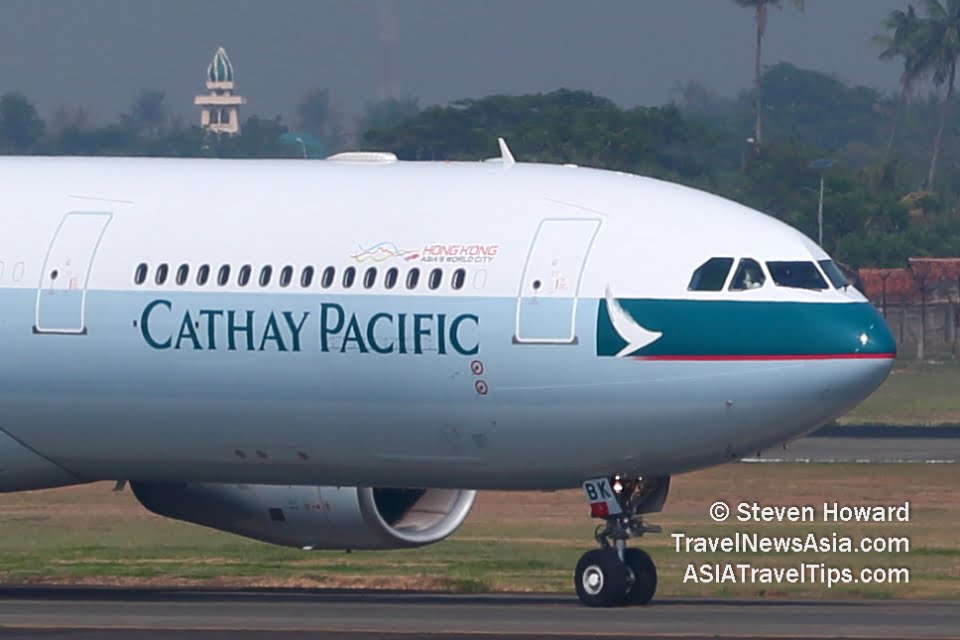Cathay Pacific carried 400,909
passengers last month, an increase of 424.5% on October
2021, but an 85.4% decrease when compared with the pre-pandemic level
in October 2019.
The month’s revenue passenger kilometres (RPKs)
increased 416.6% year-on-year, down 80.1% on October
2019.
Passenger load factor increased by 44 percentage points to
73.6%, while capacity, measured in available seat kilometres
(ASKs), increased by 108% year-on-year, down 79%
compared with October 2019.
In the first 10 months of 2022,
the number of passengers carried by the airline increased by 166% against a 20.4%
increase in capacity and a 167.8% increase in RPKs, as compared
with the same period for 2021.
“Following the Hong Kong SAR Government’s lifting of
quarantine requirements for arrivals entering Hong Kong at the end
of September, travel sentiment out of Hong Kong improved
significantly in October,” said Ronald Lam, Chief Customer and
Commercial Officer. “Demand for the first half of October
mainly stemmed from flights to Bangkok, Singapore and Seoul. We
then saw a surge in demand for travel to Japan when its quarantine
requirements for arrivals were relaxed on 11 October. We increased our regional flight frequencies, in
particular to destinations in Japan, in October. We also resumed
services to Madrid, Milan, Bengaluru, Dubai and Kathmandu last
month. More destinations and increased flight frequencies meant
more choices and better connectivity for our customers at the Hong
Kong aviation hub. Overall in October, passenger flight capacity
increased 32% compared with September and we operated 21% of our
pre-pandemic passenger flight capacity levels. Passenger numbers
increased to nearly 13,000 per day, up from over 8,800 in
September, and load factor reached about 74%.”
Cathay Pacific carried 109,425 tonnes of cargo in
October 2022, a decrease of 20.1% compared with October 2021, and a 40.2%
decrease compared with the same month in 2019.
The month’s cargo
revenue tonne kilometres (RFTKs) decreased 25% year-on-year, down 36.2%
on October 2019.
Cargo load factor
decreased by 13.9 percentage points to 69%, while capacity,
measured in available cargo tonne kilometres (AFTKs), was down by
9.9% year-on-year, a decline of 37.2% on October 2019.
In
the first 10 months of 2022, the tonnage decreased by 11.1%
against a 21.9% decrease in capacity and a 30.9% decrease in
RFTKs, as compared with the same period for 2021.
“In terms of cargo, global economic headwinds and
anti-pandemic measures on the Chinese Mainland continue to impact
trade flows and production. While our tonnage carried fell in
October year-on-year compared with the high base of 2021, it saw a
5% increase over September. We operated about 10% less cargo
capacity compared with the same time last year as we flew fewer
cargo-only passenger services. Overall, we operated about 63% of
our pre-pandemic cargo flight capacity last month,” said Mr Lam. “Our expanded network in Europe was a bright spot
with double-digit month-on-month growth in October as we resumed
more of our passenger services. This provided our cargo customers
with more options, especially for specialised shipments such as
pharmaceuticals.”
Looking ahead at the remainder of 2022, Mr Lam
said: “The group has already announced the addition of about 3,000
passenger flight sectors from October until the end of December
this year and is on track to achieve its target of operating up to
one-third of pre-pandemic passenger flight capacity levels by the
end of 2022. Travel demand for the rest of 2022 continues to
improve and is promising for the Christmas holiday period.
“Regarding cargo, while the peak season this year
will be subdued when compared to the unprecedented peak last year,
we still expect to see increased tonnage driven by seasonal
e-commerce events as well as the start of the perishables season
in the Southern Hemisphere. As the belly capacity provided by our
passenger flights increases over the months ahead, we are
extending the reach of our network and increasing the choice of
schedules for our air cargo customers.
“Earlier this year, we said that we were targeting
to be operating cash generative from August onwards. Since then,
further adjustments to travel restrictions and quarantine
requirements have come into effect in Hong Kong. As such, it is
now our expectation that the second half of 2022 will be operating
cash generative overall.
“At the same time, our 2H 2022 results
for our airlines and subsidiaries are expected to see a marked
improvement over our first-half 2022 results, although still a
loss overall for the full year of 2022. However, the results from
associates, the majority of which are recognised three months in
arrears, and which in some cases have already been announced, will
include significant losses. As a result, a substantial loss for
the group, including airlines, subsidiaries and associates, is
expected for the full year of 2022.
“Earlier this
week, the group – comprising passenger airlines Cathay Pacific and
HK Express – announced that it anticipates it will be operating
around 70% of pre-pandemic passenger flight capacity by the end of
2023, with an aim to return to pre-pandemic levels by the end of
2024, ahead of the Asia-Pacific traffic forecast issued by the
International Air Transport Association (IATA). We look forward to
being a positive driving force behind the revival of Hong Kong’s
international aviation hub status.”

